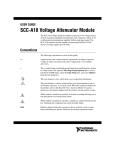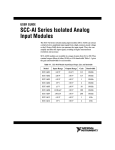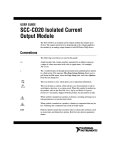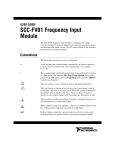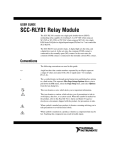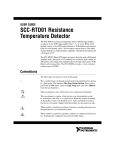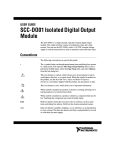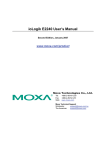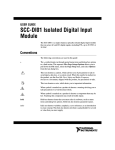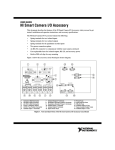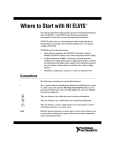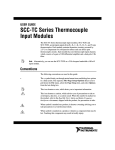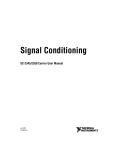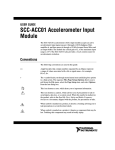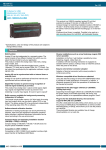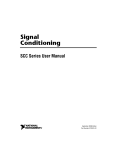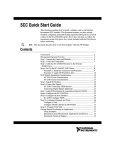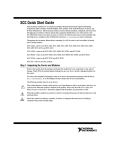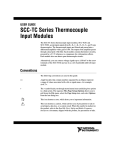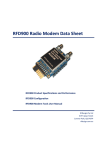Download SCC-AI Series Isolated Analog Input Modules User Guide
Transcript
USER GUIDE SCC-AI Series Isolated Analog Input Modules The SCC-AI Series isolated analog input modules can extract a relatively low-amplitude input signal from a high-common-mode voltage so the E/M Series DAQ device can measure the input signal. They also can amplify and filter the input signal, resulting in higher measurement resolution and accuracy. SCC-AI Series modules are available in a range of gains from 0.2 to 200. They contain lowpass filters of either 10 kHz or 4 Hz bandwidth. Table 1 gives the gain and bandwidth for each module. Table 1. SCC-AI Module Input/Output Range, Gain, and Bandwidth Model Input Range Output Range Gain Bandwidth SCC-AI01 ±42 Vpk / VDC ±8.4 V 0.2 10 kHz SCC-AI02 ±20 V ±10 V 0.5 10 kHz SCC-AI03 ±10 V ±10 V 1 10 kHz SCC-AI04 ±5 V ±10 V 2 10 kHz SCC-AI05 ±1 V ±10 V 10 10 kHz SCC-AI06 ±100 mV ±10 V 100 10 kHz SCC-AI07 ±50 mV ±10 V 200 10 kHz SCC-AI13 ±10 V ±10 V 1 4 Hz SCC-AI14 ±5 V ±10 V 2 4 Hz Conventions The following conventions are used in this guide: <> Angle brackets that contain numbers separated by an ellipsis represent a range of values associated with a bit or signal name—for example, AI <0..7>. » The » symbol leads you through nested menu items and dialog box options to a final action. The sequence File»Page Setup»Options directs you to pull down the File menu, select the Page Setup item, and select Options from the last dialog box. This icon denotes a note, which alerts you to important information. This icon denotes a caution, which advises you of precautions to take to avoid injury, data loss, or a system crash. When this symbol is marked on the product, refer to the Read Me First: Safety and Radio-Frequency Interference document, shipped with the product, for precautions to take. When symbol is marked on a product, it denotes a warning advising you to take precautions to avoid electrical shock. When symbol is marked on a product, it denotes a component that may be hot. Touching this component may result in bodily injury. bold Bold text denotes items that you must select in the software, such as menu items and dialog box options. Bold text also denotes parameter names. italic Italic text denotes variables, emphasis, a cross-reference, or an introduction to a key concept. Italic text also denotes text that is a placeholder for a word or value that you must supply. monospace Text in this font denotes text or characters that you should enter from the keyboard, sections of code, programming examples, and syntax examples. This font is also used for the proper names of disk drives, paths, directories, programs, subprograms, subroutines, device names, functions, operations, variables, filenames, and extensions. SC-2345 SC-2345 refers to both the SC-2345 connector block and the SC-2345 configurable connector. SCC SCC refers to any SCC series signal conditioning module. SCC-AI SCC-AI refers to any isolated analog input module in the SCC-AI Series unless otherwise noted. SCC-AI Series Isolated Analog Input Modules User Guide 2 ni.com What You Need to Get Started To set up and use the SCC-AI, you need the following items: ❑ Hardware – SCC-68 or – SC-2345/2350 with one of the following: • SCC-PWR01 • SCC-PWR02 and the PS01 power supply • SCC-PWR03 (requires a 7 to 42 VDC power supply, not included) – One or more SCC-AI – 68-pin E/M Series DAQ device – 68-pin cable – Quick Reference Label ❑ Software – The latest version of NI-DAQmx ❑ Documentation – SCC-AI Series Isolated Analog Input Modules User Guide – SC-2345/2350 User Manual – SCC-68 User Guide or – SCC Quick Start Guide – Read Me First: Safety and Radio-Frequency Interference – Documentation for your hardware – Documentation for your software ❑ Tools – 1/8 in. flathead screwdriver – Numbers 1 and 2 Phillips screwdrivers – Wire insulation stripper Software scaling of measurements is not supported on the Macintosh operating system. Refer to the SCC-AI Module Pin Assignments section. Note © National Instruments Corporation 3 SCC-AI Series Isolated Analog Input Modules User Guide You can download NI documents from ni.com/manuals. To download the latest version of NI-DAQmx, click Download Software at ni.com. Device Specific Information For general SCC module installation and signal connection information, and information about the SC-2345/2350 or SCC-68, refer to the SCC Quick Start Guide, available for download at ni.com/manuals. Note Installing the Module Caution Refer to the Read Me First: Safety and Radio-Frequency Interference document before removing equipment covers or connecting/disconnecting any signal wires. You can plug the SCC-AI into any analog input socket on the SC-2345/2350 or SCC-68. The socket you choose determines which E/M Series DAQ device channels receive the SCC-AI signals. For single-stage input conditioning, plug the SCC-AI into any slot of the SC-68, or any socket of the SC-2345/2350 J(X+1), where X is 0 to 7. Connect the input signals to the module as described in the Connecting the Input Signals section. If you use the SCC-AI in a dual-stage configuration in an SC-2345, the SCC-AI must be the first-stage module. Plug it into any socket J(X+9) and plug the second-stage SCC into socket J(X+1), where X is 0 to 7. Connect the input signals to the SCC-AI as described in the Connecting the Input Signals section. The SC-2345 connects the output signals of the first-stage SCC to the inputs of the second-stage SCC. An example of dual-stage conditioning is an SCC-AI02 followed by an SCC-FV01 frequency input module. Sockets J9 to J16 of the SC-2345 are also available for digital input/output (DIO) conditioning or control. Refer to the SC-2345/2350 User Manual for more information about configuring, connecting, and installing SCC modules. SCC-AI Series Isolated Analog Input Modules User Guide 4 ni.com Connecting the Input Signals The signal names have changed. Refer to ni.com/info and enter rdtntg to confirm the signal names. Note Each screw terminal on the SCC-AI is labeled by pin number <1..4>. Pins 1 and 2 form a channel routed to E/M Series DAQ device channel X+8, and pins 3 and 4 form a channel routed to the E/M Series DAQ device channel X, where X is 0 to 7 depending on the socket where you plug in the module. The SCC-AI provides channel-to-ground and module-to-module isolation only. It does not provide isolation between the two channels of the SCC-AI. Because both channels must have the same reference voltage, pins 1 and 3 are connected together internally. Figure 1 shows the SCC-AI signal connections. Signal Source E/M Series DAQ Device SCC-AI 4 + + Lowpass Filter – AI (X ) – 3 AI SENSE AI GND 2 + + Lowpass Filter – 1 AI (X+8) – Figure 1. SCC-AI Signal Connections The inputs are designed in a floating (nonreferenced) single-ended configuration. If the measured signals are floating, connect the negative input pins, 1 and 3, to AI SENSE on the SC-2345/2350 terminal block or AI GND on the SC-68, through a 10 kΩ to 100 kΩ resistor. Figure 2 shows a floating signal connection on one channel of the SCC-AI. © National Instruments Corporation 5 SCC-AI Series Isolated Analog Input Modules User Guide E/M Series DAQ Device SCC-AI 4 Signal Source + + Lowpass Filter – AI (X ) – 3 10 to 100 kΩ AI SENSE AI SENSE on SC-2345/2350 terminal block or AI GND on SCC-68 AI GND 2 + Lowpass Filter 1 AI (X+8) – Figure 2. Nonreferenced Signal Connection for the SCC-AI (One Channel) If a high common-mode voltage is present, connect the negative input pins, 1 and 3, to the signal reference. Figure 3 shows a ground-referenced signal connection on one channel of the SCC-AI. E/M Series DAQ Device SCC-AI 4 Signal Source + + Lowpass Filter – 3 High CMV AI (X ) – + AI SENSE – AI GND 2 + Lowpass Filter 1 AI (X+8) – Figure 3. Ground-Referenced Signal Connection for the SCC-AI with High Common-Mode Voltage (One Channel) For information about how to configure the SCC-AI module using NI-DAQmx, refer to the SCC Quick Start Guide. SCC-AI Series Isolated Analog Input Modules User Guide 6 ni.com Using the SCC-AI when Scaling Voltage Measurements If you configured the SCC-AI using Measurement & Automation Explorer (MAX) and you are using NI-DAQmx, the voltage reading you get from the E/M Series DAQ device accounts for the voltage scaling effect of the SCC-AI. Otherwise, because the voltage measurement from the E/M Series DAQ device is scaled by the gain given in Table 1, you must divide the voltage reading returned by the E/M Series DAQ device by this gain to get the correct input voltage. Calibrating Gain and Offset Errors The SCC-AI is calibrated at the factory before shipment. If you want to adjust the gain of the SCC-AI in your system using your E/M Series DAQ device, you need a voltage source that is several times more accurate than the SCC itself and capable of providing the DC voltage shown in Table 2. Table 2. SCC-AI Input Voltage Requirements Module Input Range SCC-AI01 40 V SCC-AI02 16 V SCC-AI03 8V SCC-AI04 4V SCC-AI05 800 mV SCC-AI06 80 mV SCC-AI07 40 mV SCC-AI13 8V SCC-AI14 4V Gain Adjustment To adjust the gain of the SCC-AI, complete the following steps: 1. Select the desired SCC-AI channel on the E/M Series DAQ device. 2. Set the gain on the E/M Series DAQ device so that its input range is ±10 V. 3. Connect the voltage source to the screw terminals of the desired channel on the SCC-AI. 4. Apply the voltage given in Table 2 that corresponds to the SCC-AI module. For example, if you have an SCC-AI03, you must apply 8 VDC. © National Instruments Corporation 7 SCC-AI Series Isolated Analog Input Modules User Guide 5. Using your software, have the E/M Series DAQ device read the desired channel on the SCC-AI and record the value. 6. Input 0 VDC to the SCC-AI. 7. Use the E/M Series DAQ device to read that channel and record the value. 8. Subtract the values read ( first reading – second reading). 9. Adjust the trimpot labeled Gain located on the top of the SCC-AI. If the value you obtained in step 8 is less than the input voltage, turn the trimpot clockwise to increase the gain. If it is greater than the input voltage, turn the trimpot counterclockwise to decrease the gain. 10. Repeat steps 4 through 9 until the difference you get in step 8 equals the Input Voltage Required value shown in Table 2; in this example the value is 8 V using an SCC-AI03. For example, assume that you have an SCC-AI03 module. You first connect 8 VDC to the input of CH (X). The E/M Series DAQ device reads 8.05 V as the SCC output. You then connect 0 VDC to the input of CH (X) and the E/M Series DAQ device reads –0.01 V as the SCC output. You subtract these readings, 8.05 – (–0.01) = 8.06, getting a difference of 8.06 V. Because this difference is not equal to 8 V, you must adjust the gain trimpot and repeat the procedure until the difference in outputs equals 8 V. Note In this example there can be an offset voltage such that the final readings are 8.01 V and 0.01 V for a difference of 8 V. The gain trimpot adjusted in step 9 of the previous procedure adjusts only for gain errors and does not compensate for this offset voltage. Offset Voltage Adjustment Complete the following steps to adjust the offset voltage of the SCC-AI: 1. Select the desired SCC-AI channel on the E/M Series DAQ device. 2. Set the gain on the E/M Series DAQ device so that the input range is ±10 V. 3. Connect the screw terminals of your desired channel on the SCC-AI together. 4. Using your software, have the E/M Series DAQ device read the channel. 5. If the value read is not equal to 0.00 V, adjust the appropriate trimpot located on the top of the SCC-AI, labeled Offset. Turn the trimpot clockwise to increase the offset. 6. Repeat steps 4 and 5 until the voltage read in step 4 equals 0.00 V. SCC-AI Series Isolated Analog Input Modules User Guide 8 ni.com Specifications These ratings are typical at 25 °C unless otherwise stated. Input Characteristics Number of input channels ...................... 2 NRSE Isolation.................................................. Bank isolation (isolation per module1) Input/output signal range, gain, and bandwidth ........................................ Refer to Table 1 Input impedance SCC-AI01, SCC-AI02 .................... 1 MΩ All others......................................... 100 MΩ Gain error ............................................... 4.5% max (trimmable to zero) Gain stability .......................................... 150 PPM/°C Offset error ............................................. 40 mV max (RTI2) Offset stability........................................ 225 μV/°C Nonlinearity ........................................... 0.0128% typ 0.0260% max Common-mode rejection ratio ............... 100 dB typical at 60 Hz Output slew rate, dependent on BW (filtering) .................. 0.8 V/μs max Filter Characteristics Number of poles..................................... 3 Rolloff .................................................... 60 dB/decade Cutoff frequency (–3 dB) AI0X................................................ 10 kHz AI1X................................................ 4 Hz 1 2 The SCC-AI does not provide isolation between the two channels of the module. For more information, refer to the Connecting the Input Signals section. This specification is calculated relative to the input range of the module. © National Instruments Corporation 9 SCC-AI Series Isolated Analog Input Modules User Guide Power Requirement Analog power .........................................410 mW max +15 V ...............................................13.67 mA max –15 V ...............................................13.67 mA max Digital power (+5 V) ..............................650 mW max 130 mA max Physical 1.87 cm (0.74 in.) 7.93 cm (3.12 in.) 3.55 cm (1.4 in.) Figure 4. SCC-AI Dimensions Weight ....................................................37 g (1.0 oz) I/O connectors.........................................One 20-pin right-angle male connector, one 4-pin screw terminal, removable Screw terminal wire gauge .....................24 to 12 AWG Maximum Working Voltage Maximum working voltage refers to the signal voltage plus the common-mode voltage. Channel-to-earth (inputs)........................42.4 Vpeak or 60 VDC, Measurement Category I This device is rated for Measurement Category I and is intended to carry signal voltages no greater than 42.4 Vpeak or 60 VDC. Do not use this device for connection to signals or for measurements within Categories II, III, or IV. Caution SCC-AI Series Isolated Analog Input Modules User Guide 10 ni.com Isolation Voltage Channel-to-earth isolation Continuous ...................................... 60 VDC, Measurement Category I Withstand ........................................ 2300 Vrms verified by a 5 s dielectric withstand type test Channel-to-channel ................................ Nonisolated1 Environmental Operating temperature............................ 0 to 50 °C Storage temperature ............................... –20 to 70 °C Humidity ................................................ 10 to 90% RH, noncondensing Maximum altitude .................................. 2,000 m Pollution Degree (indoor use only) ........ 2 Safety This product meets the requirements of the following standards of safety for electrical equipment for measurement, control, and laboratory use: • IEC 61010-1, EN 61010-1 • UL 61010-1, CSA 61010-1 Note For UL and other safety certifications, refer to the product label or the Online Product Certification section. Electromagnetic Compatibility This product meets the requirements of the following EMC standards for electrical equipment for measurement, control, and laboratory use: 1 • EN 61326 (IEC 61326): Class A emissions; Basic immunity • EN 55011 (CISPR 11): Group 1, Class A emissions • AS/NZS CISPR 11: Group 1, Class A emissions • FCC 47 CFR Part 15B: Class A emissions • ICES-001: Class A emissions The SCC-AI does not provide isolation between the two channels of the module. For more information, refer to the Connecting the Input Signals section. © National Instruments Corporation 11 SCC-AI Series Isolated Analog Input Modules User Guide For the standards applied to assess the EMC of this product, refer to the Online Product Certification section. Note Note For EMC compliance, operate this product according to the documentation. Note For EMC compliance, operate this device with shielded cables. CE Compliance This product meets the essential requirements of applicable European Directives as follows: • 2006/95/EC; Low-Voltage Directive (safety) • 2004/108/EC; Electromagnetic Compatibility Directive (EMC) Online Product Certification Refer to the product Declaration of Conformity (DoC) for additional regulatory compliance information. To obtain product certifications and the DoC for this product, visit ni.com/certification, search by model number or product line, and click the appropriate link in the Certification column. Environmental Management NI is committed to designing and manufacturing products in an environmentally responsible manner. NI recognizes that eliminating certain hazardous substances from our products is beneficial to the environment and to NI customers. For additional environmental information, refer to the NI and the Environment Web page at ni.com/environment. This page contains the environmental regulations and directives with which NI complies, as well as other environmental information not included in this document. Waste Electrical and Electronic Equipment (WEEE) EU Customers At the end of the life cycle, all products must be sent to a WEEE recycling center. For more information about WEEE recycling centers and National Instruments WEEE initiatives, visit ni.com/environment/weee. ⬉ᄤֵᙃѻક∵ᶧࠊㅵ⧚ࡲ⊩ ˄Ё RoHS˅ Ёᅶ᠋ National Instruments ヺড়Ё⬉ᄤֵᙃѻકЁ䰤ࠊՓ⫼ᶤѯ᳝ᆇ⠽䋼ᣛҸ (RoHS)DŽ ݇Ѣ National Instruments Ё RoHS ড়㾘ᗻֵᙃˈ䇋ⱏᔩ ni.com/environment/rohs_chinaDŽ (For information about China RoHS compliance, go to ni.com/environment/rohs_china.) SCC-AI Series Isolated Analog Input Modules User Guide 12 ni.com SCC-AI Module Pin Assignments Figure 5 shows the I/O connector pins on the bottom of the module. 4 1 2 3 5 1 Pin 1 2 Pin 2 3 PWB Key 4 Pin 19 5 Pin 20 Figure 5. SCC Module Bottom View Table 3 lists the signal corresponding to each I/O connector pin on the bottom of the SCC-AI. AI (X) and AI (X+8) are the analog input channels of the E/M Series DAQ device. AI GND is the analog input ground signal and is the reference for AI (X) and AI (X+8). A GND is the reference for the ±15 V supplies and REF 5 V. AI GND and A GND connect to the SC-2345/2350 at the SCC-PWR connector. GND is the reference for the +5 V supply. © National Instruments Corporation 13 SCC-AI Series Isolated Analog Input Modules User Guide Table 3. SCC-AI Module Pin Assignments Pin Number Signal 1 E/M Series AI (X) 2 E/M Series AI GND 3 — 4 E/M Series AI (X+8) 5 — 6 E/M Series AI GND 7 — 8 E/M Series AI GND 9 +5 V 10 GND 11 A GND 12 REF 5 V 13 +15 V 14 –15 V 15 — 16 — 17 — 18 — 19 — 20 — National Instruments, NI, ni.com, and LabVIEW are trademarks of National Instruments Corporation. Refer to the Terms of Use section on ni.com/legal for more information about National Instruments trademarks. Other product and company names mentioned herein are trademarks or trade names of their respective companies. For patents covering National Instruments products/technology, refer to the appropriate location: Help»Patents in your software, the patents.txt file on your media, or the National Instruments Patent Notice at ni.com/patents. © 2002–2008 National Instruments Corporation. All rights reserved. 371066D-01 Aug08














